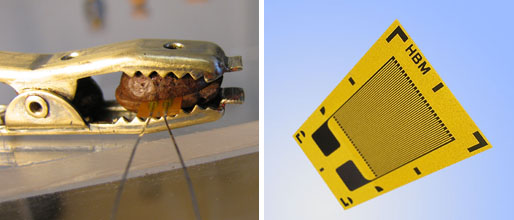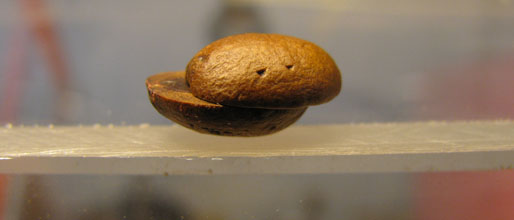The TT-3/100 temperature sensor from HBM is only 50 µm thick, with a measuring surface of 3.1 mm x 3.0 mm. With these dimensions, it comes very close to being a"punctiform"sensor, which is how it was represented in the mathematical modeling for this new method. A wide application temperature range from -50 °C to +180 °Cmakes it possible to use the sensor for both freeze-drying and roasting coffee beans.
Accurate Down to the Bean: Mini Temperature Sensor Enables Energy-Saving Coffee Production
Nearly a billion kilowatt hours of energy are expended annually by the food industry in Germany for drying and roasting coffee beans, nuts, and fruits. Finding the optimum temperature and process time is the key to major potential energy savings. Now, the German National Metrology Institute (PTB), using a compact temperature sensor from HBM, has developed a new process for measuringthe thermal conductivity and thermal diffusivity of small objects such as coffee beans.
Until now, the thermal capacity of coffee beanscould only be determined using pressed ground coffee. The structure of the material plays no role for this material constant. Thermal transport properties, on the other hand, are structure-dependent. Therefore, they can only be measured with sufficient accuracy using whole coffee beans. Since coffee beans are too small for previous measurement technology, thermal conductivity and thermal diffusivity could only be roughly estimated.
Extremely Small and Powerful

Innovative Measurement Method
Thanks to the miniature dimensions of the TT-3/100, the PTB was able to develop aninnovative measurement method for determining the thermal properties of coffee beans. The method consists of several steps. The coffee bean is divided in half with the sensor placed in between. The contact surfaces need to be smooth to ensure good thermal contact. The sensor is not glued in place; rather, it is clamped, and acts as both a temperature sensor and defined source of heat at the same time.
With a power supply of 8 to 10 mA, the TT-3/100 heats up during measurement. The more the bean conducts inside heat to the outside, the faster and more intensely the temperature and electrical resistance of the sensor rise.
The measurement results for thermal diffusivity and thermal conductivity are ready in just a few minutes. It is also possible to calculate the specific thermal capacity of the bean if its density is known. That material property can simply be determined according to Archimedes' principle. Instead of thermal conductivity, the humidity of a beancan also be determined.

Accurate and Reliable Results
The reliability of the method has been demonstrated, starting with reference specimens with precisely known thermal transport properties. The measured values for specific heat of a bean can be compared with those of ground coffee. They match very closely.
Efficient Measurement for Various Applications
Dr. Ulf Hammerschmidt of the PTB is confident that the new method will open up newapplications in diverse industries. The importance of thermal conductivity and thermal diffusivity as material parameters extends well beyond the food industry. The method can also speed uptesting, monitoring, and approval of new insulation materials in the building industry, providing reliable results within minutes, compared to a few days. Assessments of existing building materials could be supported by simple field measurements.
Cooperation as the Basis for Innovation
PTB makes its technology available through licenses. HBM, in turn, cooperates with the PTB license holders. The close collaboration among PTB, license holders and HBMforms anideal basis for innovative development. Dr. Hammerschmidt expressed his approval: "We like working together with HBM. With them, we find the technical competence and reliable, high-quality products we need for trend-setting methods."
The customer: PTB
Learn more about PTB, German National Metrology Institute.